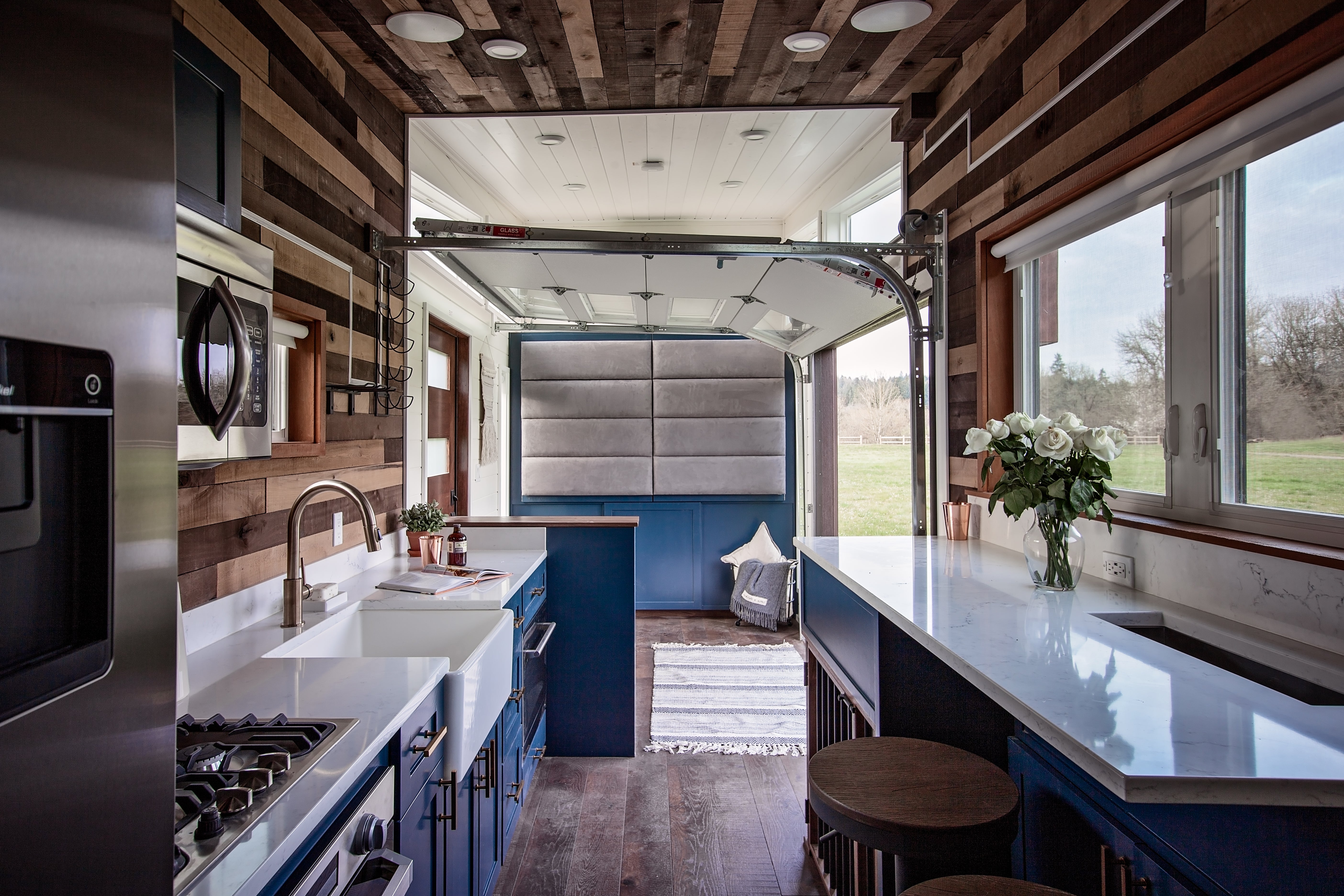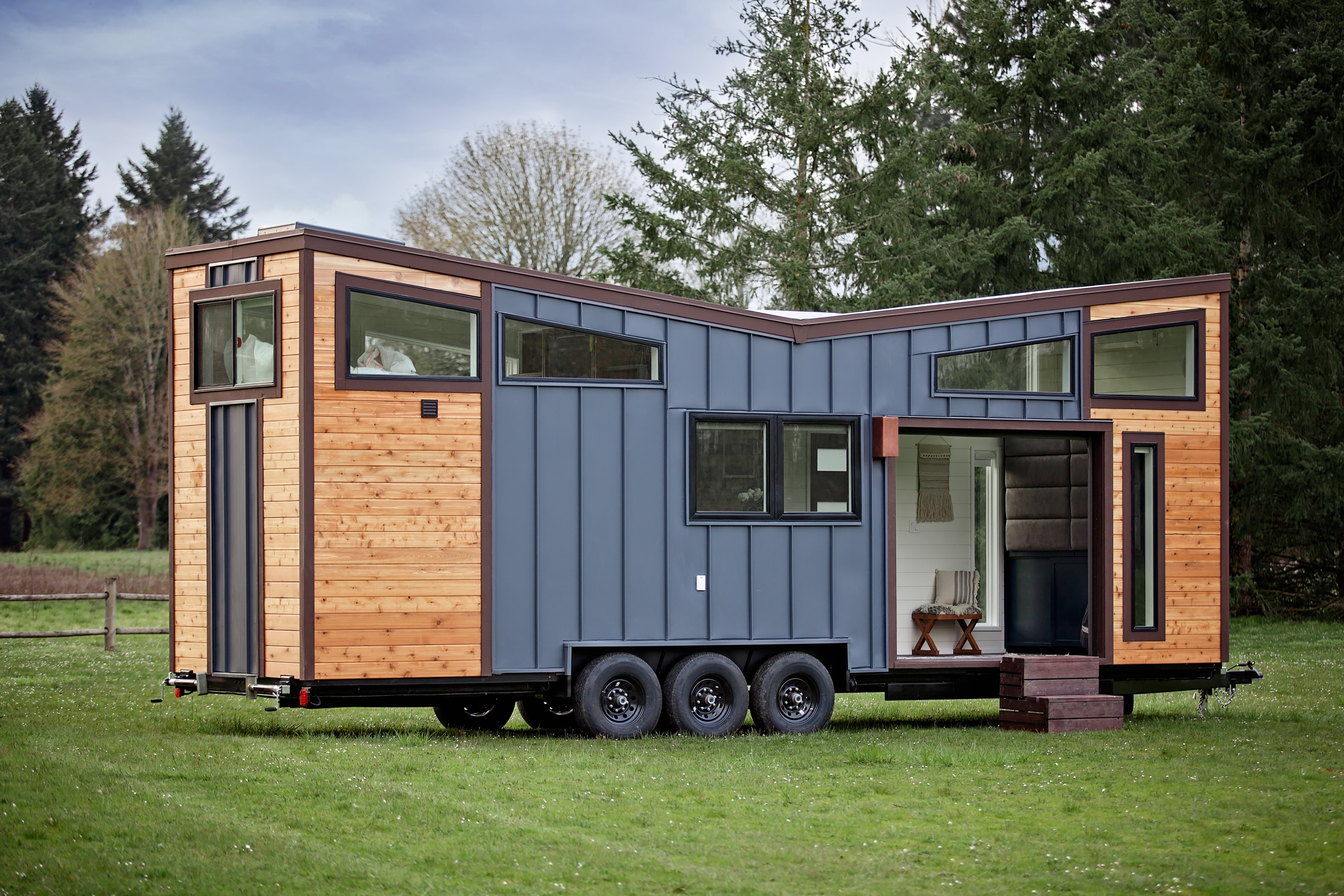1. Motors in Retractable and Convertible Furniture
For any tiny home, space-saving is crucial, and motors make this possible by transforming furniture into multi-functional units at the push of a button. Electric motors bring convenience to designs that would otherwise be cumbersome to operate manually:
Motorized Beds: A motorized Murphy bed or loft bed can retract into the wall or ceiling when not in use, instantly opening up floor space for daytime activities. Motors enable these beds to be stowed and deployed smoothly, even with the added weight of mattresses and bedding.
Convertible Desks and Tables: Dining tables, desks, or counters that fold away after use are often motorized for ease of operation. With motorized lifting and lowering mechanisms, these pieces of furniture can be effortlessly stored away, saving valuable space.
Automated Sofa Beds: Motorized sofa beds can transform from couches into beds without the manual struggle. These systems allow for a seamless day-to-night transition, making it simple to convert spaces depending on the time of day or activity.
2. Motorized Storage Solutions
Storage is vital in any small space, and motorized storage solutions offer an innovative way to stow items without taking up room unnecessarily. Motors assist in hiding and revealing storage compartments as needed, allowing homeowners to keep items out of sight without sacrificing accessibility.
Lift-Up Cabinets: Motorized cabinets, often installed above counters or beds, can lift or drop at the touch of a button, granting easy access to stored items and retracting when not in use. This vertical storage solution is a game-changer for tiny homes with limited surface area.
.png)
Retractable Staircases and Ladders: Some tiny homes feature retractable staircases or ladders that are motorized to lower only when needed, such as when accessing loft areas. These motorized systems keep pathways clear when not in use, maximizing the use of available space.
Hidden Pantry Systems: In kitchens, motorized pantry systems bring shelves out from under counters or behind walls, making even small kitchens feel well-stocked and organized.
3. Motors for Solar Panel Efficiency
Renewable energy is a key component of tiny home living, and motors contribute to this by increasing the effectiveness of solar energy systems. Motorized solar panels can track the sun throughout the day, ensuring optimal energy generation without requiring additional panels or battery capacity.
Sun-Tracking Solar Mounts: Tiny homes can use motorized mounts that tilt and rotate solar panels to follow the sun’s trajectory. By maximizing sun exposure, these tracking systems help tiny homeowners generate more power from a smaller array, which is particularly important when roof space is limited.
Adjustable Awning Solar Panels: Some modular homes feature awning-style solar panels that can deploy or retract depending on weather conditions and energy needs. When extended, these panels can provide shade and additional energy collection; when retracted, they help the home maintain a compact profile.
4. Motorized Climate Control Elements
Tiny and modular homes often rely on efficient climate control, and motors help ensure consistent temperature management while conserving energy. By controlling the positioning and ventilation within the home, motors play a role in maximizing comfort and minimizing energy expenditure.
Motorized Windows and Vents: Motorized windows and skylights can open and close automatically based on the home’s internal temperature or weather conditions. This automation regulates airflow and keeps the indoor environment comfortable without over-reliance on heating or air conditioning.
Ventilation Fans: In tight spaces, ventilation is essential to maintain air quality and prevent condensation. Small motors in ventilation systems help circulate air efficiently, providing much-needed airflow in bathrooms, kitchens, and loft areas.
Automated Shades: Motorized blinds or shades help tiny homeowners control sunlight and heat gain. By programming shades to rise and fall with the sun, residents can manage both light and temperature passively, reducing the need for artificial lighting or HVAC systems.
.jpeg)
5. Motors in Kitchen Appliances
Tiny homes are embracing compact and efficient appliances, many of which are motorized to deliver high performance without taking up too much space. These motorized appliances keep small kitchens functional, offering full-size capabilities in a fraction of the space:
Retractable Range Hoods: A motorized range hood that deploys only when cooking helps reduce the visual clutter in a tiny kitchen. By retracting after use, it leaves the kitchen looking open and seamless while still providing necessary ventilation.
Compact Dishwashers and Mixers: Small, motorized dishwashers and mixers allow homeowners to enjoy modern conveniences without the need for oversized appliances. These units are typically energy-efficient and space-saving, tailored for limited kitchen setups.
6. Security and Safety Motors
In tiny and modular homes, security is a top priority, especially for those living in remote or rural areas. Motors integrated into security and safety systems enhance peace of mind without demanding additional space:
Motorized Door Locks: Smart locks with motorized deadbolts provide a high level of security without the bulk of traditional security systems. These can be controlled remotely, adding a layer of convenience for tiny homeowners.
Automated Fire Suppression Systems: Some tiny homes are equipped with motorized fire suppression systems that activate in response to smoke or heat. These systems, often concealed in cabinetry or walls, deploy automatically to protect the home from fire risks.
Motorized Security Shutters: For added privacy and protection, tiny homes can feature motorized shutters or blinds that close when the home is unoccupied, safeguarding the interior from both natural elements and potential intruders.
7. Mobility Motors for Modular and Mobile Homes
Modular homes aren’t just stationary structures—many are designed for mobility, with motors powering systems that enable relocation and setup:
Motorized Leveling Systems: Mobile tiny homes and modular units often require leveling to provide stability. Motorized leveling systems adjust the home’s foundation automatically, allowing for setup on uneven terrain without manual intervention.
.png)
Slide-Out Rooms and Expandable Sections: Some modular homes use motorized systems to expand or contract rooms. With the press of a button, a section of the home can slide out to create extra space and slide back in for transport, adding versatility to the layout.
Towing and Hitch Mechanisms: For mobile tiny homes, motorized hitch mechanisms allow easy attachment and detachment from trailers. These motorized systems simplify the moving process and ensure that the home is secure when on the road.
8. Innovations in Water and Waste Management
Motors are also instrumental in handling water and waste in tiny homes, where self-sufficiency is often a priority. Compact pumps, grinders, and disposal units powered by small motors help maintain hygienic and efficient living conditions:
Water Pump Systems: Many tiny homes rely on water tanks, which require motorized pumps to deliver water to sinks, showers, and appliances. These pumps maintain consistent water pressure while conserving energy.
Composting Toilets: Motorized fans and agitators are often integrated into composting toilets to aid in waste breakdown and reduce odors. These units are ideal for off-grid tiny homes and provide a sustainable, compact waste management solution.
Greywater Recycling Systems: For homes with water recycling systems, motorized pumps circulate greywater to be filtered and reused for irrigation or flushing toilets, promoting sustainable water use in a compact footprint.
Final Thoughts
The presence of motors in tiny and modular homes represents a fusion of convenience and ingenuity, maximizing the livability of these spaces without compromising on essential comforts. By integrating motors into furniture, appliances, energy systems, and more, tiny homes embody a high-tech approach to sustainable, space-efficient living. As technology continues to advance, motors will likely play an even greater role in shaping tiny homes, allowing them to become even more adaptable, functional, and eco-friendly.






Share: